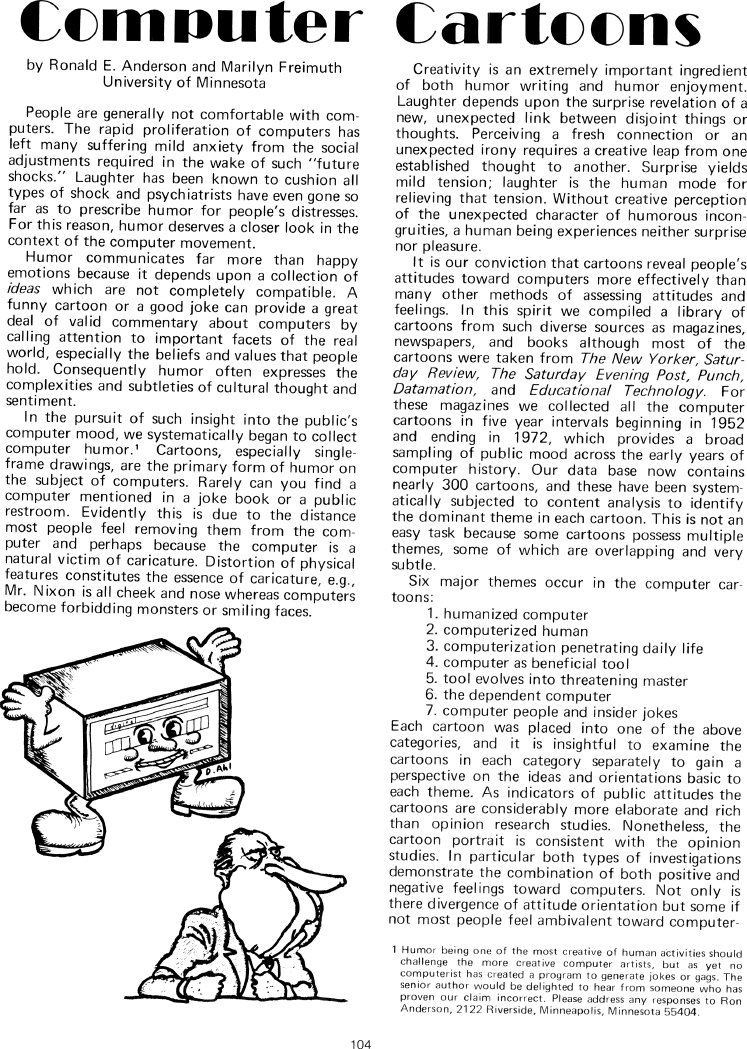The Best of Creative Computing Volume 1 (published 1976)
Computer Cartoons (themes in cartoons about computers)

Computer Cartoons
by Ronald E. Anderson and Marilyn Freimuth
University of Minnesota
People are generally not comfortable with computers.
The rapid proliferation of computers has
left many suffering mild anxiety from the social
adjustments required in the wake of such "future
shocks.” Laughter has been known to cushion all
types of shock and psychiatrists have even gone so
far as to prescribe humor for people's distresses.
For this reason, humor deserves a closer look in the
context of the computer movement.
Humor communicates far more than happy
emotions because it depends upon a collection of
ideas which are not completely compatible. A
funny cartoon or a good joke can provide a great
deal of valid commentary about computers by
calling attention to important facets of the real
world, especially the beliefs and values that people
hold. Consequently humor often expresses the
complexities and subtleties of cultural thought and
sentiment.
ln the pursuit of such insight into the public's
computer mood, we systematically began to collect
computer humor.‘ Cartoons, especially single frame
drawings, are the primary form of humor on
the subject of computers. Rarely can you find a
computer mentioned in a joke book or a public
restroom. Evidently this is due to the distance
most people feel removing them from the computer
and perhaps because the computer is a natural
victim of caricature. Distortion of physical
features constitutes the essence of caricature, e.g.,
Mr. Nixon is all cheek and nose whereas computers
become forbidding monsters or smiling faces.
\ Ffa .,..~»»"‘'lf'i'}' ''
j_w.cs»~ i
§‘é
'*'' ul R
\
&r "
~ ri
if limi
104
Creativity is an extremely important ingredient
of both humor writing and humor enjoyment.
Laughter depends upon the surprise revelation of a
new, unexpected link between disjoint things or
thoughts. Perceiving a fresh connection or an
unexpected irony requires a creative leap from one
established thought to another. Surprise yields
mild tension; laughter is the human mode for
relieving that tension. Without creative perception
of the unexpected character of humorous incongruities,
a human being experiences neither surprise
nor pleasure.
It is our conviction that mcartoons reveal people's
attitudes toward computers more effectively than
many other methods of assessing attitudes and
feelings. In this spirit we compiled a library of
cartoons from such diverse sources as magazines,
newspapers, and books although most of the
cartoons were taken from The New Yorker, Saturday Review,
The Saturday Evening Post, Punch,Datamation, and Educational
Technology. For these magazines we collected all the computer
cartoons in five year intervals beginning in 1952
and ending in 1972, which provides a broad
sampling of public mood across the early years of
computer history. Our data base now contains
nearly 300 cartoons, and these have been systematically
subjected to content analysis to identify
the dominant theme in each cartoon. This is not an
easy task because some some possess multiple
themes, some of which are overlapping and very
subtle.
Six major themes occur in the computer cartoons:
1. humanized computer
2. computerized human
3. computerization penetrating daily life
4. computer as beneficial tool
5. tool evolves into threatening master
6. the dependent computer
7. computer people and insider jokes
Each cartoon was placed into one of the above
categories, and it is insightful to examine the
cartoons in each category separately to gain a
perspective on the ideas and orientations basic to
each theme. As indicators of public attitudes the
cartoons are considerably more elaborate and rich
than opinion research studies. Nonetheless, the
cartoon portrait is consistent with the opinion
studies. In particular both types of investigations
demonstrate the combination of both positive and
negative feelings toward computers. Not only is
there divergence of attitude orientation but some if
not most people feel ambivalent toward computer
1 Humor being one of the most creative of human activities should
challenge the more creative computer artists, but as yet no
compuierist has created a program lo generate jokes or gags. The
senior author would be delighted to hear from someone who has
proven our claim incorrect. Please address any responses to Ron
Anderson, 2122 Riverside, Minneapolis, Minnesota 55404.


